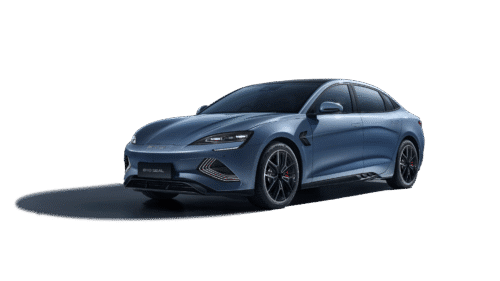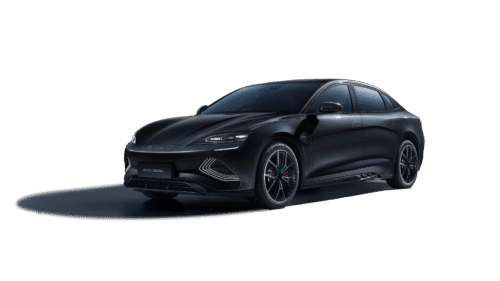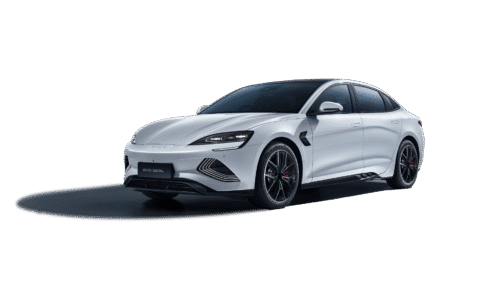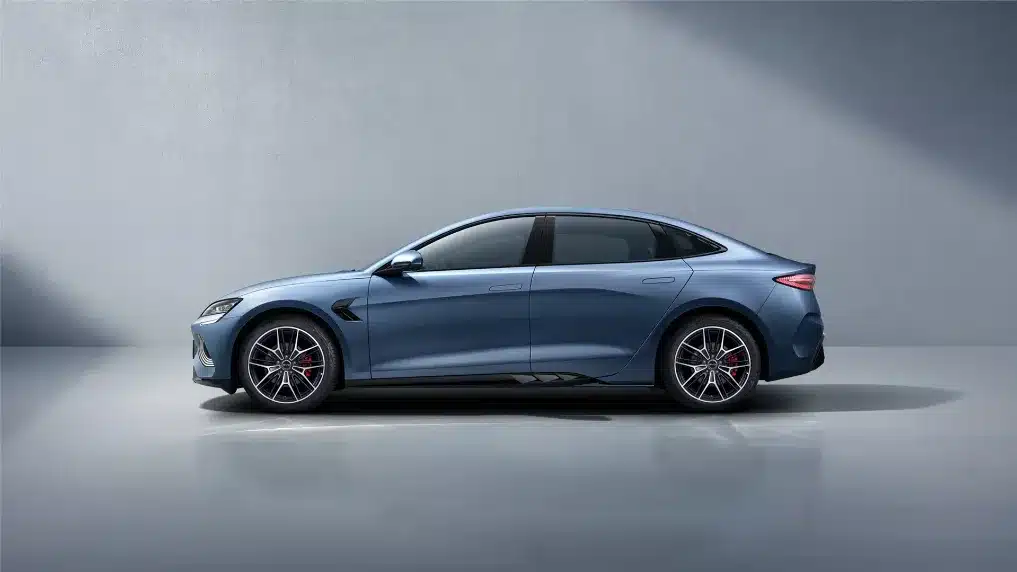The BYD Seal marks BYD’s bold entry into the premium electric-sedan segment aimed at customers who want a driver-focused EV that still offers everyday practicality. With a coupe-like roofline, aerodynamic body, and BYD’s own Blade LFP battery technology, the Seal blends performance, range, and modern tech in a single package. It’s pitched as a competitor to the likes of the Tesla Model 3 and other global electric sedans, but it also brings BYD’s vertically integrated battery and software strengths to the table. For buyers in markets such as India, the Seal arrives as one of the most feature-rich, fully imported electric sedans available.
Design & exterior — sporty, clean, and aerodynamic

The BYD Seal Viewed from the outside, the Seal emphasizes a low, flowing silhouette and minimalist detailing. Flush door handles, a long bonnet, and a gently sloping fastback roof give it a sporty, aerodynamic stance that helps with efficiency at highway speeds. The front fascia typically features slim LED headlights and a clean bumper layout; the rear usually includes a full-width light bar that visually widens the car at night. Aerodynamic shaping is not just for looks — BYD Seal engineers focused on reducing drag to improve real-world range. The result is a contemporary design language that feels modern without being gimmicky.
Interior & technology — large screens and thoughtful packaging

BYD Seal Inside, the Seal favors a driver-centric layout with a large rotating center display as the showpiece. Depending on market and trim, the interior includes a digital instrument cluster, heads-up display, premium seating materials, and a panoramic glass roof. BYD’s rotating 15.6-inch infotainment screen (where offered) gives a neat usability edge — portrait for maps, landscape for media — while the software layer provides connected services, over-the-air updates, and an assistant for many common vehicle tasks. Practical touches such as generous front and rear legroom, multiple storage cubbies, and vehicle-to-load (V2L) capabilities make the Seal suitable for both daily commuting and longer trips.
Platform & battery tech — e-Platform 3.0 + Blade battery explained

Two of the Seal’s biggest technical selling points are BYD’s e-Platform 3.0 and its Blade LFP battery. e-Platform 3.0 is BYD’s dedicated EV architecture; it centralizes electric powertrain components, optimizes wiring and energy flow, and integrates structural elements to improve safety and efficiency. The Blade battery — a lithium iron phosphate (LFP) chemistry arranged in a thin, space-efficient format — emphasizes thermal stability and lifecycle longevity. BYD also uses “Cell-to-Body” construction on newer models, where the battery structure becomes part of the car’s load-bearing structure to increase rigidity and crash protection. In practice, these systems aim to deliver a long battery life, improved safety, and competitive energy efficiency.
BYD Seal Variants, battery sizes, and claimed range (India overview)
BYD Seal typically offers the Seal in multiple trims with two battery capacities for most markets:
- Dynamic (entry RWD) — ~61.44 kWh Blade LFP battery; RWD motor; claimed range around 510 km (manufacturer / CLTC/market-specific figure).
- Premium (mid RWD) — ~82.56 kWh Blade LFP battery; stronger single-motor setup; highest claimed range up to 650 km in ideal conditions.
- Performance (AWD) — same 82.56 kWh pack in a dual-motor AWD configuration that prioritizes acceleration; claimed range is lower than the single-motor variant (around ~580 km in some testing/claims) but offers sports-car level 0–100 km/h times.
Important: range figures vary by test cycle (CLTC, WLTP, EPA) and real-world driving (speed, climate control use, city vs highway). Indian figures are manufacturer-claimed and should be tested in real conditions for practical planning.
Performance numbers — quick or comfortable depending on trim
BYD Seal Performance scales with trim:
- The BYD Seal, RWD single-motor Seal in base form is brisk enough for daily use with mid-7-second 0–100 km/h times in many spec sheets.
- The BYD Seal, Premium single-motor trim can push sub-6-second acceleration depending on tuning.
- The BYD Seal, Performance AWD variant is the headline performer, with published 0–100 km/h runs around 3.8 seconds in manufacturer/press material — sports-car territory for a four-door sedan. These acceleration claims make the Seal one of the quickest mid-segment EVs on paper.
Bear in mind that peak acceleration reduces range and places greater demand on thermal management; BYD’s battery and powertrain cooling will influence how repeatable those runs are. BYD
Charging & electricals — speeds, V2L, and practical use
The BYD Seal charging ability depends on battery pack and onboard systems. Common commercial specs show support for DC fast charging at up to 110 kW (Dynamic) or 150 kW (Premium / Performance) on certain trims, allowing 30–80% top-ups in roughly 30–40 minutes under ideal conditions and with suitable chargers. AC charging at home will be slower (typically 7 kW single-phase home chargers where applicable), and BYD includes vehicle-to-load capability (V2L) on some variants — useful for adapters, camping, or emergency power. Always confirm local charging compatibility and speeds with BYD Seal or the dealer before purchase.
Safety & NVH — Blade battery advantages and build quality
The Blade LFP battery emphasizes safety: compared with some other chemistries, it is less prone to thermal runaway and can tolerate abuse better. BYD’s integration of the battery as a structural element further increases crash stiffness and, BYD claims, improves occupant protection. In global crash testing and early independent tests, BYD Seal, models with the Blade battery have shown competitive results — however, always check local NCAP results for your region and the specific seal configuration. Noise, vibration, and harshness (NVH) levels on the Seal are generally reported as good for the class, with insulation and suspension tuning favoring a comfortable, composed ride over razor-sharp sportiness.
Practicality & ownership — luggage, space, and service
The BYD Seal balances style with decent packaging: a usable rear seat for adults, reasonable boot volume for a sedan, and foldable seats in some markets for extended cargo. As of early availability in countries like India, the Seal was sold as a completely built unit (CBU), which can influence maintenance costs, parts availability, and pricing compared to locally built rivals. BYD has been expanding its aftersales footprint, but new buyers should confirm warranty, roadside assistance, service network, and parts lead times at the dealer level before committing.
Pricing snapshot (India, 2025 launch figures)
At launch in India the BYD Seal’s ex-showroom pricing (model year 2025) was positioned approximately as:
- BYD Seal Dynamic (entry) — ₹41,00,000 (ex-showroom)
- BYD Seal Premium (mid) — ~₹45,70,000 (ex-showroom)
- BYD Seal Performance (top AWD) — ~₹53,15,000 (ex-showroom)
These figures make the Seal a premium imported EV in India’s market and put it in a direct price conversation with other premium EVs and ICE luxury cars once incentives and local taxes are considered. Always verify current pricing with BYD India or an authorized dealer (prices may change due to local taxes, incentives, or company pricing updates).
Real-world range expectations — what to expect day to day
Manufacturer range claims are often measured under idealized test conditions. In everyday driving, expect a realistic reduction in range caused by higher average speeds, the use of climate control (especially in hot climates), and heavier loads. In urban stop-start traffic the regenerative braking and low speeds may improve practical efficiency, but frequent fast runs and highway cruising at high speeds will reduce the achievable distance per charge. For planning: treat claimed figures as optimistic and use conservative estimates (for example, 10–25% lower than the claimed number) when planning long trips, or confirm by reading independent owner feedback and tests in your specific region and climate.
How the Seal compares to main rivals (brief)
- Tesla Model 3: Tesla still leads with charging network convenience in many markets, proven software updates, and a strong resale profile. The BYD Seal competes closely on range and undercuts on price in some trims while offering Blade battery safety and a different approach to interiors and infotainment. If you value an extensive fast-charging network and established EV ecosystem, Tesla remains strong; if battery safety, value, and built features matter, the Seal is compelling.
- Hyundai Ioniq 5 / Kia EV6: These deliver unique designs and excellent chassis dynamics; BYD’s Seal often beats them on claimed range per rupee and offers comparable tech in many trims. Build quality and aftersales network are strengths for Hyundai/Kia in many countries, so weigh service convenience vs range/price.
- Other premium EVs: In markets with a growing EV lineup from legacy brands, the Seal’s Blade battery, long CLTC figures and strong value proposition are its main selling points — particularly for buyers who prioritize battery longevity and safety.
Pros & cons — quick checklist
Pros
- Competitive claimed range and strong energy efficiency for its class.
- Blade LFP battery emphasizes safety and longevity.
- Sporty acceleration in AWD Performance trim — sub-4-second 0–100 km/h on paper.
- Premium interior tech, rotating infotainment screen, and V2L capabilities on some variants.
Cons
- As a mostly imported premium EV in some countries, parts and service can be more expensive or slower than local rivals.
- Real-world range will vary; manufacturer figures are best-case and can be optimistic. Wikipedia
- Charging network coverage depends heavily on the local public fast-charging infrastructure; plan long trips accordingly.
Buying advice — who the Seal is for, and what to check
Who it’s good for:
- Buyers who want strong electric range, modern tech, and sporty performance in a sedan body.
- Tech-minded drivers who value battery innovations and BYD’s vertically integrated approach.
- Those who want an alternative to Tesla that emphasizes battery chemistry safety (LFP) and high claimed all-electric range.
Pre-purchase checklist:
- Test drive the specific trim you plan to buy — ride, NVH, and driving feel differ between RWD and AWD performance variants.
- Confirm charging speeds and home-charger options with the dealership. If you plan long trips, map available public DC fast chargers for the route.
- Ask about warranty & battery warranty terms, and what the dealer’s service lead times are for parts. Confirm roadside assistance coverage.
- Read independent owner feedback or community forums for real world range and reliability reports in your region. Data from local owners will be most relevant.
Aftermarket & ownership costs — what to expect
Electric vehicles typically have lower routine maintenance (no engine oil, fewer moving parts), but imported models can have higher costs for certain components and labour. Battery health is a major long-term factor; BYD’s Blade battery design focuses on longevity (high cycle life), but real-world degradation depends on charging habits, climate, and usage. Factor in the cost of home charging installation, electricity rates, and the frequency of using public DC fast chargers (which can cost more per kWh). BYD
Final verdict — who should buy the BYD Seal?
The BYD Seal is a strong contender in the premium EV sedan segment. It offers a persuasive mix of range, technology, and performance, backed by BYD’s battery and platform expertise. For buyers who prioritize battery safety, claimed long range, and sharp performance — and who are comfortable with an imported premium EV’s potential tradeoffs in service or resale — the Seal represents excellent value. If widespread public fast-charging convenience or an established resale ecosystem is top priority, consider that alongside your local infrastructure and dealer readiness.
If you’re in the market, the most practical next steps are: book a test drive, confirm local on-road pricing and warranty details, and speak to local Seal owners or community reviews to validate real-world range and service experiences in your city.
- iQOO 15: Battery, Display, Price Power and Cooling
- Music Interesting Fact About You Don’t know
- क्या CV Engine इलेक्ट्रिक कारों का Game Over कर देगा?
- The Ultimate 4-Week Dumbbell-Only Strength Program for Beginners
- Can CV Engine Kill Electric Cars
Sources & further reading
Key sources used while preparing this guide (for the most up-to-date figures check BYD India or your local dealer):
- BYD India — official model pages and pricing announcements.
- Livemint — India launch coverage and technical breakdown (April 2025).
- BYD global/europe pages — e-Platform 3.0 and Blade battery technology briefs.
- EVSpecifications / regional BYD sites — performance numbers and AWD claims.
- Car buyer portals (CarWale, CarHP) — local pricing ranges and user impressions.
- iPhone 17 Pro Max Launch Date: 10 Reasons to Wait for iPhone 17 Series
- How to buy a perfect jacketcoat trouser | Josforup
- क्या BRICS देश मिलकर अपनी मुद्रा बना सकते है?
- Best Website Speed Test
- JPG to PNG to WEBP converter
- Convert Any File Into PDF
- Facts About Tomatoes That You May Not Know
- Age Calculator
- Vicky Kaushal & Katrina Kaif Announce Pregnancy: A New Chapter Begins
Table of Contents
4 February 5 Star Bharat NCAP SUV India amazing fact Android Phones Apple iPhone 17 Launch Date Cheap Products under GST Close the Care Gap Costly Products GST 2025 Current Affairs 2025 Design Exams EXCELLENT SCENARIO fact Flagship Killer GK Notes for Exams GST 2025 GST on Electronics 2025 GST on Food Items GST on Luxury Goods GST Rate Cut 2025 GST Updates India Health hindi important questions india Indian railway iPhone 17 Pro iPhone 17 Pro Max iPhone 17 Pro Max Camera Mobile Offers 2025 New GST Slabs India OnePlus Performance Republic Day 2025 rrb bank SCO Members Smartphone Snapdragon 8 Elite Gen 5 Some Questions Tax Free Items India Tech News Technology United by Unique We can. I can तथ्य

1 thought on “BYD Seal — The Complete Guide (Specs, Range, Price, Review & Buying Advice)”